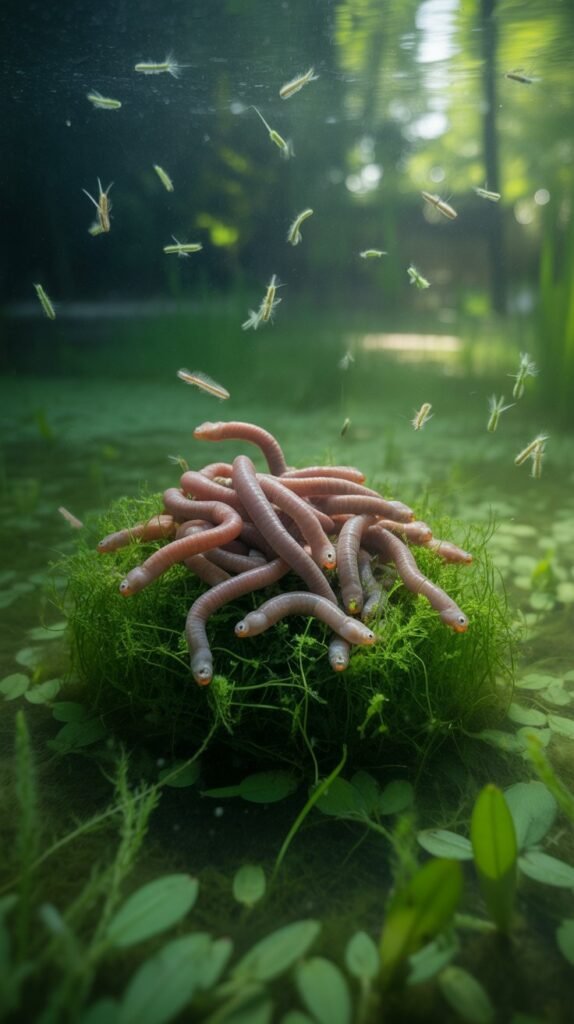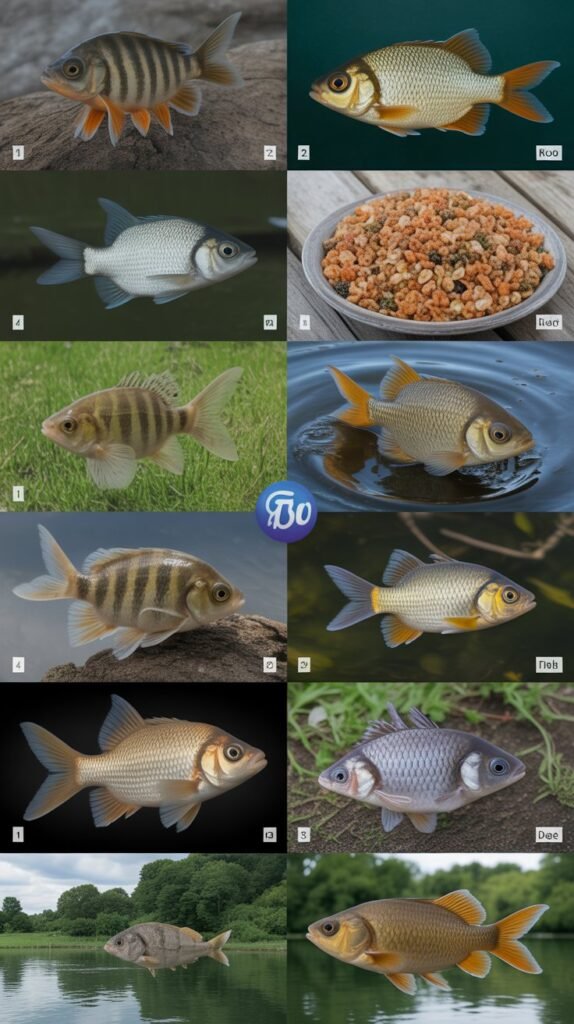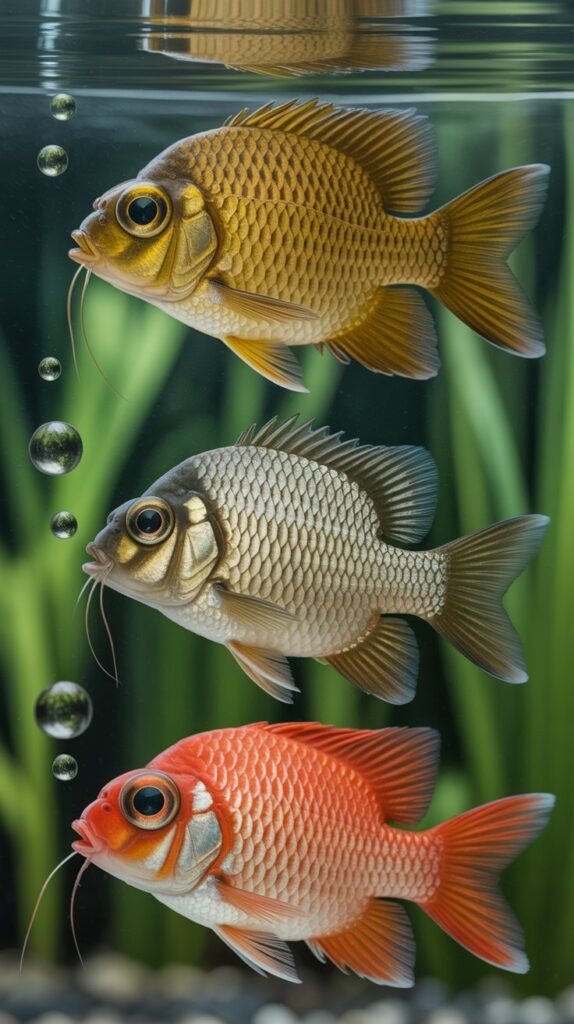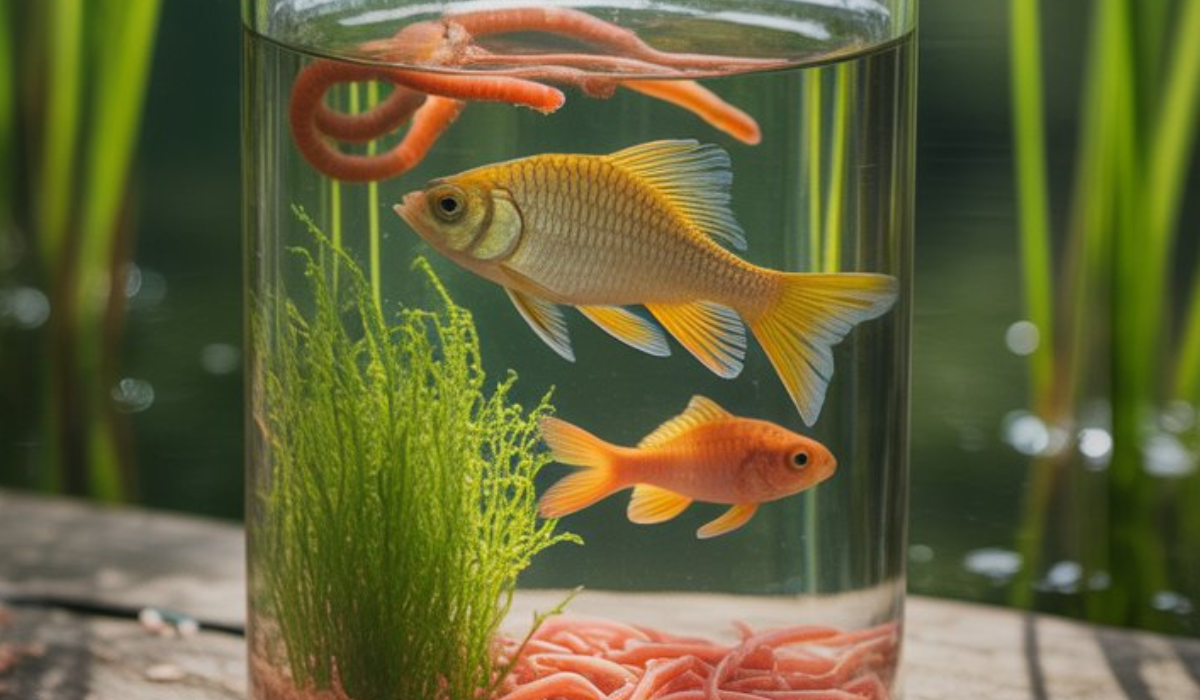Feeding your pond fish the right diet is one of the most important aspects of maintaining a healthy, thriving pond ecosystem. While commercial fish pellets and flakes provide balanced nutrition, live food for pond fish offers a natural, protein-rich, and stimulating diet that mimics what fish would eat in the wild.
From tiny aquatic insects to worms and crustaceans, live foods play a vital role in enhancing color, boosting immunity, and promoting natural hunting behavior among pond fish. Whether you keep koi, goldfish, guppies, mollies, or other ornamental species, introducing live food can transform their overall health and activity levels.
In this comprehensive guide, we’ll explore everything you need to know about live food for pond fish — including the types, benefits, how to culture them, feeding tips, and essential safety precautions.
Why Feed Live Food to Pond Fish?
Pond fish, like all aquatic animals, evolved to hunt and eat living prey. Live food provides:
1. Superior Nutrition
Live foods are rich in proteins, amino acids, and natural fats, essential for growth, energy, and muscle development.
2. Improved Digestion
Fresh, natural food is easier to digest compared to processed pellets, leading to less waste and cleaner water.
3. Enhanced Colors
Live food such as brine shrimp and daphnia are loaded with carotenoids that intensify fish coloration — especially in koi, goldfish, and guppies.
4. Natural Feeding Behavior
Catching live prey encourages exercise and reduces boredom or aggression among pond fish.
5. Boosted Immunity
Nutrient-dense live foods strengthen fish immune systems, helping them resist diseases and parasites.
6. Better Breeding Performance
Live foods stimulate breeding instincts and improve fertility, especially in species like guppies, bettas, and koi.
Top Types of Live Food for Pond Fish

There are many options when it comes to live food for pond fish — from micro-organisms to larger prey. Below are the most popular and beneficial ones.
1. Daphnia (Water Fleas)
Description: Tiny crustaceans that swim in jerky movements and are ideal for small to medium fish.
Benefits:
- Excellent source of protein and fiber
- Great for cleaning fish digestive systems
- Encourages natural feeding instincts
Feeding Tip: Offer live daphnia 2–3 times a week. Avoid overfeeding, as they can die quickly in warm water.
Culturing: Daphnia can be cultured in green water (algae-rich water) with a gentle air supply.
2. Brine Shrimp
Description: Small saltwater crustaceans ideal for both young and adult pond fish.
Benefits:
- Rich in carotenoids, improving fish coloration
- High in proteins and omega-3 fatty acids
- Suitable for fry and adult fish
Culturing: Brine shrimp eggs (Artemia cysts) can be hatched in saltwater using an air pump and light source.
Feeding Tip: Rinse brine shrimp in freshwater before feeding to pond fish to remove excess salt.
3. Bloodworms
Description: The red larvae of midge flies — a favorite among koi and goldfish.
Benefits:
- High in iron and protein
- Promotes rapid growth
- Encourages natural foraging
Availability: Available live or frozen.
Caution: Avoid overfeeding, as too many bloodworms can lead to fatty liver issues.
4. Tubifex Worms
Description: Thin, red worms that live in the sediment of rivers and ponds.
Benefits:
- Excellent protein content
- Stimulates appetite
- Ideal for large pond fish like koi and catfish
Caution: Wild-caught tubifex worms may carry harmful bacteria or parasites. Always purchase from trusted sources or culture them at home.
5. Blackworms
Description: Similar to tubifex but cleaner and safer for aquarium or pond use.
Benefits:
- Great for improving fish stamina
- Highly nutritious and easy to digest
- Encourages natural hunting
Feeding Tip: Rinse thoroughly before feeding to ensure no debris enters your pond.
6. Earthworms
Description: Natural, protein-rich food source for larger pond fish like koi and catfish.
Benefits:
- Packed with amino acids and minerals
- Promotes muscle growth and vitality
- Enhances color and breeding performance
Feeding Tip: Chop into smaller pieces for medium-sized fish. Feed occasionally to prevent overconsumption of fats.
7. Mosquito Larvae
Description: Small, wriggling larvae found in standing water — a favorite for most fish species.
Benefits:
- High in protein and natural oils
- Promotes active feeding behavior
- Eco-friendly method to control mosquitoes in ponds
Caution: Do not allow mosquito larvae to fully mature into adults. Collect and feed them before pupation.
8. Grindal Worms

Description: Small, white worms perfect for small or juvenile pond fish.
Benefits:
- Easy to culture indoors
- Great for fry growth and development
- Soft-bodied and highly digestible
Culturing: Can be cultured in moist soil with oatmeal or bread as food.
9. Fruit Flies
Description: Wingless or flightless fruit flies are suitable for surface-feeding fish species.
Benefits:
- Excellent source of proteins and lipids
- Stimulates top-water feeding behavior
- Adds variety to diet
Feeding Tip: Release small quantities to prevent leftovers floating on the surface.
10. Copepods
Description: Tiny crustaceans that are part of the natural plankton community.
Benefits:
- Perfect for fish fry and small pond species
- Enhance color and growth
- Rich in essential fatty acids
Culturing: Grows well in green water or tanks with algae.
11. Snails and Small Crustaceans
Description: Some larger pond fish like cichlids and koi eat small snails and crustaceans.
Benefits:
- Provide calcium and protein
- Support jaw and tooth strength
- Natural foraging enrichment
Tip: Only feed pest-free snails from controlled environments.
Benefits of Feeding Live Food to Pond Fish
Let’s take a deeper look at how live foods can transform your pond ecosystem.
1. Enhanced Nutrition and Growth
Live foods provide complete amino acid profiles and omega-3 fatty acids that promote rapid growth, muscle development, and better health.
2. Natural Color Enhancement
Carotenoids found in daphnia, brine shrimp, and worms intensify the natural red, orange, and yellow pigmentation of koi and goldfish.
3. Better Water Quality
Unlike uneaten pellets that decay, live foods move and get eaten quickly — reducing waste buildup.
4. Mental and Physical Stimulation
Chasing live prey mimics wild conditions, reducing boredom and aggression among fish.
5. Improved Breeding Behavior
Feeding live foods triggers breeding hormones, increasing fertility and fry survival rates.
How to Culture Live Food at Home

Culturing live food for your pond is both rewarding and cost-effective. Here’s how you can easily start:
1. Daphnia Culture
- Use a shallow container filled with green water or aged aquarium water.
- Add a small starter culture of daphnia.
- Feed with yeast or powdered spirulina daily.
- Keep under indirect sunlight with aeration.
2. Brine Shrimp Hatchery
- Mix 1 tablespoon of salt per liter of water.
- Add brine shrimp eggs and aerate continuously.
- Eggs hatch in 24–36 hours at 25–28°C.
- Harvest using a fine net and rinse before feeding.
3. Worm Culture (Grindal or Blackworms)
- Use moist coco fiber or peat moss as a substrate.
- Feed with oatmeal, bread, or fish food flakes.
- Keep moist but not waterlogged.
- Harvest worms after a few days using a mesh screen.
4. Mosquito Larvae
- Place a small bucket of water outdoors.
- Add grass clippings or leaves to attract mosquitoes.
- Collect larvae with a fine net before they pupate.
Feeding Tips for Pond Fish
- Feed Small Quantities Frequently: Overfeeding can cloud water and reduce oxygen levels.
- Combine with Pellets: Use a mix of live food and commercial diet for balanced nutrition.
- Feed During Daylight: Most pond fish feed actively during the day.
- Avoid Contaminated Sources: Never collect live food from polluted or stagnant water.
- Rinse Before Feeding: Remove dirt or debris before adding to the pond.
- Monitor Fish Behavior: Observe feeding to prevent aggression or leftover waste.
Safety and Hygiene Precautions
While live food is nutritious, it can also introduce unwanted pathogens or parasites if not handled properly.
Tips for Safe Feeding:
- Source from trusted suppliers or culture your own.
- Avoid collecting from wild or unknown sources.
- Rinse in dechlorinated or aged water before use.
- Quarantine new live food cultures for a few days.
- Do not feed decomposing or dead live food.
By maintaining hygiene, you can enjoy all the benefits of live feeding without health risks to your fish.
Best Live Food for Specific Pond Fish Species
| Fish Species | Recommended Live Food |
|---|---|
| Koi | Earthworms, bloodworms, brine shrimp |
| Goldfish | Daphnia, tubifex worms, mosquito larvae |
| Guppies | Brine shrimp, grindal worms, daphnia |
| Mollies | Copepods, mosquito larvae, blackworms |
| Tilapia | Earthworms, snails, brine shrimp |
| Catfish | Tubifex, earthworms, insects |
Advantages of Culturing Your Own Live Food
- Cost-effective: Reduces dependency on store-bought feeds.
- Control over quality: Ensures no contamination.
- Sustainability: Eco-friendly and renewable food source.
- Customization: You can culture specific species depending on your fish’s needs.
Live Food vs. Prepared Food: Which Is Better?
| Feature | Live Food | Prepared Food (Pellets/Flakes) |
|---|---|---|
| Nutritional Value | High in protein and natural fats | Balanced nutrients |
| Stimulation | Encourages natural hunting | Passive feeding |
| Color Enhancement | Natural carotenoids | Artificial color enhancers |
| Shelf Life | Short | Long |
| Risk of Disease | Possible (if contaminated) | Low |
Verdict: The best strategy is to combine both live and prepared foods for complete, balanced nutrition.
How Often Should You Feed Live Food?
Feeding live food 2–3 times a week is ideal for most pond fish. However:
- During breeding seasons, feed more frequently.
- In colder months, reduce feeding since fish metabolism slows down.
Environmental Impact of Live Food
Feeding live food helps replicate a natural ecosystem in your pond. It promotes a healthy food chain — where fish, insects, and microorganisms coexist harmoniously.
However, avoid releasing non-native species or overpopulating your pond with certain prey, as it may disrupt the ecological balance.
Conclusion
Incorporating live food for pond fish is one of the best ways to enhance the health, color, and vitality of your aquatic pets. Live foods like daphnia, brine shrimp, bloodworms, and earthworms provide unmatched nutrition and mimic the natural diet of fish in the wild.
To keep your pond fish thriving:
- Alternate between live and prepared foods.
- Source or culture live food safely.
- Maintain proper feeding hygiene.
When used correctly, live food can transform your pond into a lively, balanced ecosystem filled with vibrant, active, and healthy fish.
FAQs About Live Food for Pond Fish
1. What is the best live food for pond fish?
Daphnia, brine shrimp, bloodworms, and mosquito larvae are among the best live foods for most pond fish species.
2. Can I feed pond fish live earthworms?
Yes! Earthworms are safe, highly nutritious, and loved by larger pond fish like koi and catfish.
3. How often should I feed live food to my fish?
Feed live food 2–3 times a week along with regular pellets to maintain a balanced diet.
4. Can live food cause diseases in fish?
Yes, if sourced from contaminated environments. Always buy from reputable suppliers or culture your own.
5. Is live food necessary if I feed pellets?
Not strictly necessary, but live food significantly improves growth, coloration, and natural behavior.
6. Can I raise live food at home?
Absolutely! Daphnia, brine shrimp, and grindal worms are easy to culture with minimal equipment.
7. Do small pond fish eat live food?
Yes, small species like guppies, mollies, and tetras thrive on micro-live foods like copepods and daphnia.
8. How should I store live food?
Keep in cool, oxygenated water and feed within a few days. Never store for long periods.
9. Can live food improve fish breeding?
Yes, live food stimulates breeding hormones and enhances fry survival rates.
10. Is live food eco-friendly?
Yes. Culturing live food at home is sustainable, natural, and helps reduce dependency on commercial feeds.

